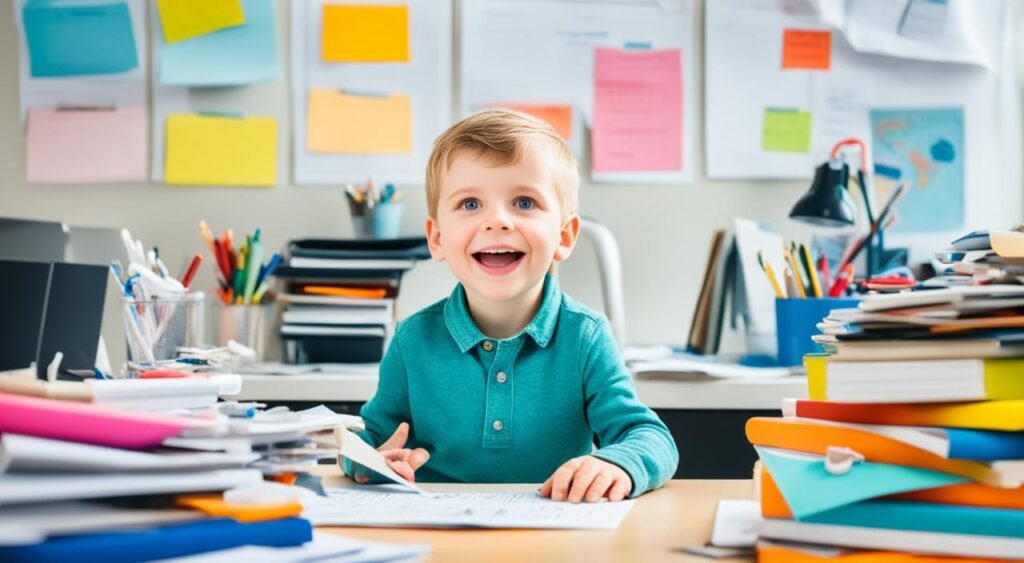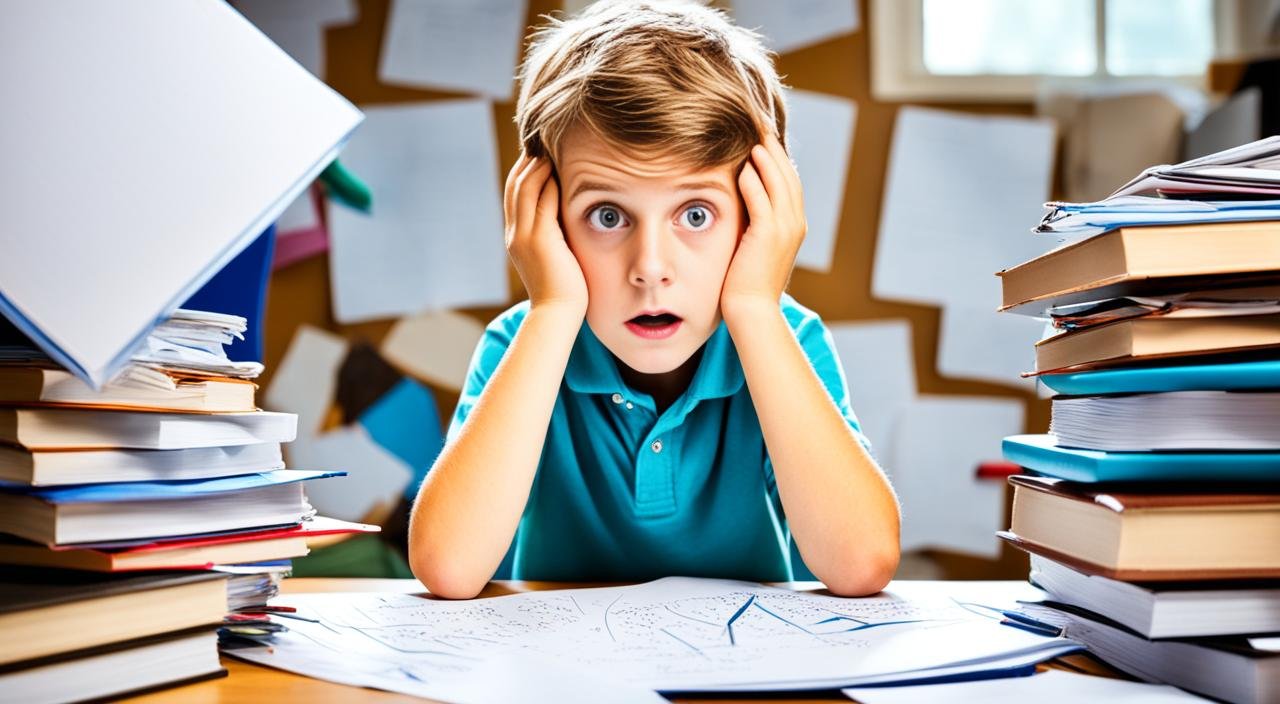Many children with attention deficit hyperactivity disorder (ADHD) may seem lazy to adults. The symptoms of ADHD overlap with laziness, like trouble finishing tasks and focusing. It’s key to know the difference between laziness and the neurological causes of ADHD. This will help us give the proper support and care to these children.
Kids with ADHD find it hard to keep their attention and manage tasks. This makes them look lazy when they’re not. ADHD is a brain-based disorder that affects how a person regulates focus and impulse. It’s very harmful to call these children “lazy”. They might not get the support they need to do well.
Key Takeaways
- ADHD symptoms can often be mistaken for laziness, leading to frustration for both parents and children.
- Children with ADHD may struggle with sustaining effort, processing information, and completing tasks, which can be perceived as a lack of motivation.
- Recognizing the underlying neurological factors behind ADHD is crucial to avoid labeling a child as “lazy” and instead, address their specific challenges.
- Understanding the differences between laziness and ADHD is essential for providing the right support and interventions for children with this condition.
- Seeking professional guidance can help parents better understand and address the unique needs of children with ADHD.
Understanding ADHD and Executive Function Deficits
ADHD is a condition that affects how someone focuses, pays attention, and controls impulses. It’s tied to problems in key areas like planning and finishing tasks. These issues with executive functions are key to understanding ADHD.
Challenges with Sustaining Effort and Processing Speed
People with ADHD often find it hard to stay focused and put in effort for long. Others might wrongly see this as laziness. In truth, those with ADHD struggle to keep up with the attention and speed needed for tasks.
Difficulties with Long Instructions and Overwhelming Information
Handling complex instructions or lots of information is tough for people with ADHD. Their executive functions make it hard to process and remember these details. This can make them feel overwhelmed or checked out. Knowing this is important for finding ways to support them.
By understanding and addressing the unique challenges of ADHD, we can really help those affected. We can provide support that meets their specific needs and helps them succeed.
Strategies for Avoiding Overwhelm and Increasing Focus

It’s vital to find ADHD strategies that work for each child. Helping them break big tasks into small steps is a good start. This makes tasks seem easier and less scary for kids with ADHD.
Breaking Down Large Tasks into Smaller Steps
Large tasks can be scary for children with ADHD. Breaking them into smaller parts helps. They can check off each part as they finish, feeling good about their progress. This task management method also fights the feeling of being overwhelmed, which might make kids delay or quit.
Using Visual Cues to Reduce Distractions
Visual aids like checklists or timers are great for kids with ADHD. They help them stay focused and avoid distractions. In short, they make it easier for the kids to concentrate on their work.
Providing Clear and Concise Instructions
Keeping directions short and to the point really helps kids with ADHD. They can find long explanations hard to follow. Sticking to clear communication gets the message across without confusing them. This way, they’re more likely to understand what’s expected.
These steps are a big help for parents and teachers. They can support children with ADHD in meeting their challenges. Ultimately, this approach fosters better focus and performance both at school and in daily life.
Is my child lazy or ADHD?
Parents sometimes find it hard to tell if their child is just laziness or has ADHD symptoms. Laziness shows as not wanting to put in the effort or having low motivation. However, ADHD symptoms can look similar. They might struggle to begin tasks or to finish them.
It’s important to note the behavioral differences and developmental delays linked to ADHD. This knowledge is key to giving the right help and support. So, understanding these differences is important for parents.
Common Signs of ADHD in Children
Children with ADHD may show various symptoms, such as:
- A short attention span
- Being easily distracted
- Being disorganized
- Putting off tasks
- Having poor impulse control
These signs can be seen asADHD symptoms in children
orlaziness
. Figuring out the real cause can be hard. By learning about theneurological factors
andbehavioral patterns
linked to ADHD, parents can understand and support their child better.
The Brain and ADHD: Neurotransmitters and Executive Function
ADHD is a brain-based disorder that changes how the brain works. People with ADHD may have less neurotransmitters like dopamine. These chemicals are key for controlling motivation, attention, and focus.
Role of Dopamine in Motivation and Attention
Dopamine is important for focus and drive. If someone with ADHD doesn’t have enough dopamine, they might find it hard to pay attention or finish tasks. This lack of dopamine can lead to people thinking they’re not trying hard enough.
Brain Imaging and ADHD
Studies using brain imaging have shown why people with ADHD struggle. When they try to focus, their brain’s blood flow to the prefrontal cortex drops. The prefrontal cortex helps with executive function, which includes things like planning, organizing, and controlling impulses.
Knowing how neurotransmitters and brain images relate is key. It helps in making effective treatments and supporting those with ADHD. By targeting the root of ADHD, healthcare workers can meet the unique needs of patients.
Conclusion
ADHD is more than just being slow or not paying attention. It’s about the brain working differently. By knowing this, parents can help their children better. They can use ways to help them focus and understand things clearly.
Getting help from pros is key. It means these kids can get what they need to do well. When parents know how to support their kids and understand ADHD better, good things happen. Kids with ADHD can succeed more.
FAQ
Is my child lazy or ADHD?
Many children facing ADHD can seem lazy. This is because the symptoms can look like for not trying. This mix-up can really stress both parents and kids. Knowing what sets laziness apart from ADHD is key. This helps in giving the right help.
What are the challenges faced by children with ADHD?
ADHD makes it hard for kids to keep up effort and finish jobs. This can seem like they’re not trying or just don’t want to. It’s crucial to realize that the brain works differently for these kids. This helps not to label them as “lazy.”
How can I help a child with ADHD overcome challenges with focus and task completion?
To help a child with ADHD, focus on lessening stress and boosting their interest. Start by breaking big tasks into smaller steps. Use visuals and clear instructions. This helps them understand and complete tasks better.
What are the common signs of ADHD in children?
Some signs of ADHD are a short attention span, easily getting distracted, and being disorganized or putting things off. Poor impulse control is also common. Knowing these signs and the brain science behind them can help parents figure out what’s happening. It also guides them to get the right help.
How does the brain function in individuals with ADHD?
Studies show that those with ADHD might have lower dopamine levels. This can affect their motivation and focus. When they try to focus, brain scans show less blood to the prefrontal cortex. This is the part that helps us plan and stay focused. So, they might find it harder to keep their attention.





